EGU is the largest European geoscientific conference, and it is no surprise that many FYORD members attended. This month for the FYORD Travel Grant reports you will find some more EGU reports. Stay tuned to find out where the FYORD members travel to in the next month! Naveen’s impression of EGU 2024 I am Naveen, […]
Drifter im Einwegglas
English version below Die physikalische Ozeanographie beschäftigt sich in großen Teilen mit Meeresströmungen: wo sie genau verlaufen, wie stark sie sind und ob sie sich verändern. Im vorherigen Blogeintrag ging es um die Verankerungen, die unter anderem Strömungsgeschwindigkeiten messen können. Diese Methode, also ein Messgerät an einem festen Punkt zu installieren und aufzuzeichnen, was vorbeifließt, […]
Shedding some light – investigating the effects of light pollution on macroalgae off the Northwestern coast of Wales, UK
Snugly tucked in between the unpredictable currents of the Menai Strait and the jagged mountain ridges of Snowdonia lies the city of Bangor. Not so much a city, but rather a small town, Bangor is home to about 10,000 citizens and another 8,000 students who bring the town to life during lecture terms. Towering over […]
Overcoming lack of funding as a PhD Fellow to attend EGU 24
I’m Mafalda, a 29-year-old Portuguese woman doing my doctorate at the University of Kiel with a Portuguese PhD fellowship that allows me to develop my project with the cooperation of GEOMAR and the Portuguese Institute for the Sea and Atmosphere (IPMA). I’m doing my PhD in Marine Geology studying a natural submarine system where carbon […]
Interview mit dem Kapitän
Auf diesem Blog liegt der Fokus der Einträge meistens auf der Forschung und den Wissenschaftler*innen. Unsere ganze Arbeit wäre aber gar nicht möglich, ohne die Hilfe der Crew des Schiffes. Sie sorgt hinter den Kulissen dafür, dass alles läuft und wir uns wohlfühlen an Bord. Deshalb soll es heute mal ein bisschen mehr um die […]
Verankerungsarbeit
English version below Es beginnt der zweite Teil unserer Forschungsreise. Wir fahren im Moment Richtung Norden in die Labradorsee. Inzwischen ist es mit einer Lufttemperatur um 4°C richtig kalt geworden. Wir sind auf dem Weg zum 53. Breitengrad. Dort liegen fest verankerte Geräte, die zum Beispiel Temperatur, Salzgehalt, Sauerstoff und Strömungsgeschwindigkeiten messen können. Man kann […]
Aufenthalt in St John’s Kanada
English version below Mit dem Ende des ersten Teils unserer Forschungsfahrt haben wir den Hafen von St. John’s erreicht. Nachdem die Maria S. Merian noch lange in Nebel gehüllt war, tauchte dann ganz plötzlich der Eingang der Bucht von St. John’s auf. Nach Pass- und Zollkontrolle durften wir dann zum ersten Mal seit dem Start […]
Seamounts
English version below Geht man auf eine Wanderung in den Bergen, so schaut man sich meistens als ersten Schritt eine Karte an. Genauso ist es auch auf dem Ozean wichtig eine Karte zu haben. Nicht nur eine Karte, in der die Küsten und Inseln verzeichnet sind, sondern vor allem eine detaillierte Karte der Topografie des […]
Enlightenment in Japan – how artificial light at night influences local kelp forests.
いらっしゃいませ – welcome! Greetings GAME is back in Japan! Once again, an international two-person team, made up of a German and a Japanese student, is based at the Akkeshi Marine Station on Hokkaido, Japan, to contribute to this year’s pioneering research on the effect of artificial light at night on marine macroalgae. GAME GAME projects […]
FYORD Travel Grant Reports: Impressions from the largest European geoscientific conference (Part 1)
With this blog post, we would like to introduce and launch our new cooperation with FYORD! FYORD is a joint network by CAU and GEOMAR initiated to connect and support Early Career Researchers of the marine sciences from Master’s to PostDoc level. After occasional exchanges in the past (see our blog here), we are very […]



